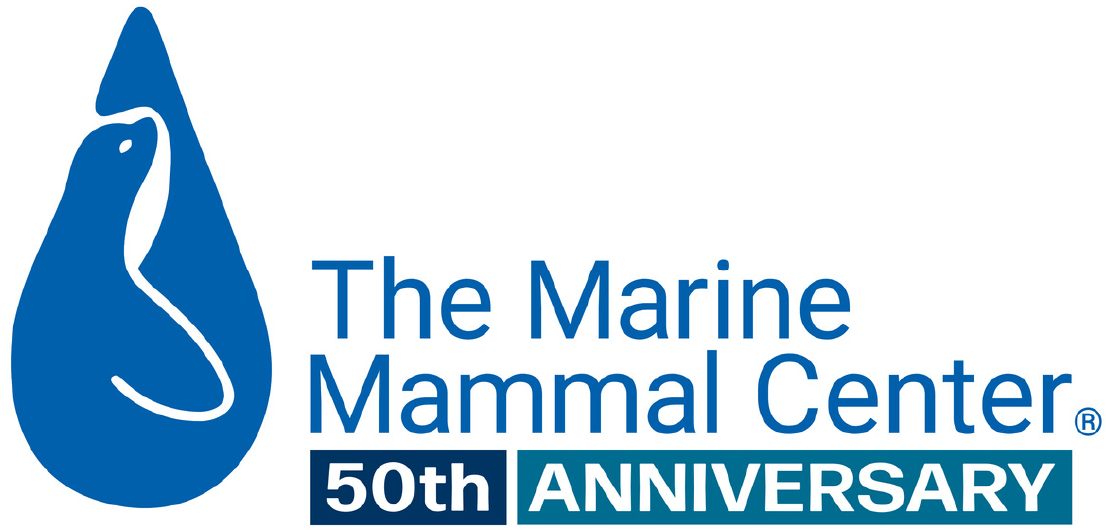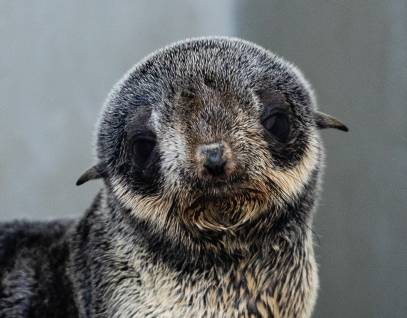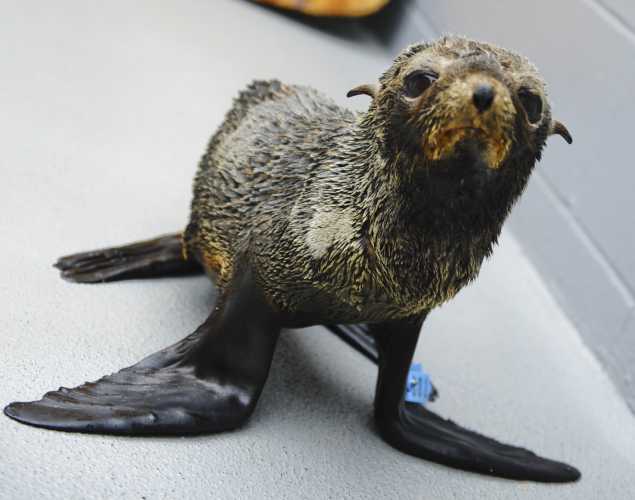
Rare Guadalupe Fur Seals Stranding in Record Numbers
- Telemetry
- Species conservation
- Climate change
California sea lions aren’t the only pinnipeds in crisis this year. Guadalupe fur seals, a threatened species, seem to be struggling with the same food availability issues and have stranded along our coast at five times the record yearly rate.
With their diminutive snouts, extra-long front flippers and outstretched ear flaps, Guadalupe fur seal pups can appear almost alien-like, especially when wet. But this year, the appearance of these furry “Yodas” is more than just a little unusual—it’s downright alarming.
So far in 2015, The Marine Mammal Center has rescued 27 Guadalupe fur seals—more than five times the record high we’ve seen in our 40 years.
These numbers pale in comparison to the more than 1,100 California sea lions we’ve rescued during this same time period, but relatively speaking, the influx of Guadalupe fur seals is just as distressing, if not more so.
Unlike California sea lions, which are thriving with a population estimated at 300,000 individuals, Guadalupe fur seals are currently listed as Threatened under the U.S. Endangered Species Act with as few as 34,000 individuals remaining. Little is known about this elusive species, which spends most of its time offshore, fishing for food in deeper waters.
What we do know about Guadalupe fur seals is that their primary breeding ground is Guadalupe Island, 150 miles off the coast of Baja California. Their life cycle is similar to their more abundant sea lion cousins. Mothers give birth on the island in June and July, and temporarily leave their pups on the beach for several days as they forage for food nearby. They return frequently to nurse their pups over the course of about nine months.
Scientists say that the unusually warm waters that have been affecting food availability for mother sea lions near the Channel Islands have also been affecting the waters near Guadalupe Island. As fish populations change in response to these warmer waters, mother fur seals may have a harder time finding the food they need to nourish themselves and their pups. Once the pups are weaned, they too seem to be having trouble finding the food they need.
“These stranded animals are just the tip of the iceberg in terms of animals affected by the unusually warm water temperatures we’ve been seeing off the coast,” says Tenaya Norris, the Center’s marine scientist.
Most of the Guadalupe fur seals we’ve seen this year have been young animals stranding in an emaciated condition not unlike the sea lion pups.
Guadalupe fur seal Silkster was admitted to the Center’s hospital on April 2 weighing just 17 pounds. Less than two weeks later, Rico was admitted at 14 pounds. Though both of these pups were about 10 months old at the time, they tipped the scales at barely over birth weight, which is estimated to be about 13 pounds for a healthy pup.
A Silver-Coated Lining
As our veterinary experts continue to care for emaciated patients like these, our researchers are using this unusual occurrence to learn as much as they can about this threatened species.
“We rarely, if ever, see Guadalupe fur seals near shore,” says Geno DeRango, a stranding coordinator at The Marine Mammal Center. “So the animals that strand on our beaches provide researchers with some of the only opportunities to learn more about their natural history and biology.”
Patients at the Center typically get an admit exam during which blood and tissue samples might be taken to help the Center’s veterinary team determine the cause of stranding. These samples can also contribute to future research, such as genetic studies.
But in the case of Guadalupe fur seals, researchers lack baseline data for even the most basic information, like the standard length for certain age classes.
At every opportunity, animal experts like DeRango, who has worked extensively with fur seals, have been taking detailed measurements of these rare patients. Because Guadalupe fur seals are especially feisty for their size and difficult to restrain due to their thick, silky fur, most of these opportunities arise when animals are under anesthesia for a procedure or exam.
For most patients, release exam measurements include a final weight and length. For Guadalupe fur seals, the list is much longer, including everything from ear and whisker lengths to the length of fur extending down each flipper.
These morphometric data points help scientists understand how animals grow and age over time. The information can even help researchers identify a species using limited remains, such as a single tooth or bone.
DeRango has been collecting these data as part of a collaborative project with Sue Pemberton, Curatorial Assistant and Specimen Preparator at California Academy of Sciences, our stranding network partner for recovering dead marine mammals.
Pemberton and her team have collected 31 Guadalupe fur seal specimens so far this year, more than doubling their collection in just a few months!
The morphometric data they are compiling from these specimens and the patients at the Center has never been collected for Guadalupe fur seals, aside from a few animals. It’s important work that is helping to fill in scientific gaps for this poorly studied species.
Learn More About Guadalupe Fur Seals
{"image":"\/Animals\/Patients\/Guadalupe fur seals\/2018\/gfs-snaggle-by-dana-angus-c-the-marine-mammal-center-noaa-permit-18786.jpg","alt":"Guadalupe fur seal patient Snaggle","label":"Pinnipeds","title":"Guadalupe Fur Seal","link_url":"\/animal-care\/learn-about-marine-mammals\/pinnipeds\/guadalupe-fur-seal","type":"page"}
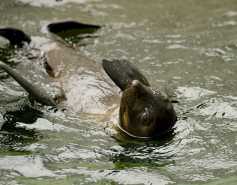
{"image":"\/Animals\/Patients\/Guadalupe fur seals\/2018\/cropped-images\/gfs-snaggle-by-cara-field-c-the-marine-mammal-center-noaa-permit-18786-376-0-3571-2789-1602455471.jpg","alt":"Guadalupe fur seal Snaggle","title":"Severe Entanglements Threaten Recovery of Guadalupe Fur Seals","link_url":"https:\/\/www.marinemammalcenter.org\/news\/severe-entanglements-threaten-recovery-of-guadalupe-fur-seals","label":"News Update","date":"2020-08-14 05:00:00","type":"news"}

{"image":"\/Animals\/Patients\/Guadalupe fur seals\/2020\/cropped-images\/gfs-pippin-by-bill-hunnewell-c-the-marine-mammal-center-noaa-permit-18786-111-120-3738-2920-1602702191.jpg","alt":"Guadalupe fur seal Pippin","title":"Understanding the Impacts of Climate Change on Threatened Guadalupe Fur Seals","link_url":"https:\/\/www.marinemammalcenter.org\/publications\/understanding-the-impacts-of-climate-change-on-threatened-guadalupe-fur-seals","label":"Research Paper","type":"publication"}

Understanding the Impacts of Climate Change on Threatened Guadalupe Fur Seals
Read More{"image":"\/Animals\/Patients\/Guadalupe fur seals\/2019\/cropped-images\/gfs-scooter-release-photo-c-steve-sayles-878-376-4402-3438-1606346089.jpg","alt":"Guadalupe fur seal","title":"Ecology and Conservation of Pinnipeds in Latin America: Guadalupe Fur Seal","link_url":"https:\/\/www.marinemammalcenter.org\/publications\/ecology-and-conservation-of-pinnipeds-in-latin-america-guadalupe-fur-seal","label":"Research Paper","type":"publication"}

Leaving a Legacy
The more we know about Guadalupe fur seals, the better we can protect this threatened species and ensure its continued survival. That’s why the research doesn’t end when a Guadalupe fur seal patient leaves our hospital.
Silkster, one of the pups rescued in early April, was deemed ready for release on June 5 after more than doubling in weight during his two months at our hospital. During his final release exam, as DeRango took measurements, Marine Scientist Tenaya Norris applied a small satellite tag to his fur with special waterproof glue.
The tag is fitted with an antenna that can send data to satellite receivers any time the animal surfaces, providing researchers with information about Silkster’s location. Although monitoring has just begun, Norris already knows that Silkster has headed northward after being released at Point Reyes National Seashore, an area known to have productive waters that support abundant fish.
A few days later, a larger Guadalupe fur seal, a juvenile male named Ian, was released at the same location with a slightly bigger satellite tag called a “splash” tag that includes sensors that tell researchers how many dives an animal makes as well as the length of dive.
A similar tag attached to Sterling Archer, an adult female Guadalupe fur seal we released last year, provided researchers with valuable information about where this species may spend time foraging.
Silkster and Ian are just two of the many Guadalupe fur seals we hope to release this year. As patients like Rico continue to improve, our researchers will prepare to fit them with satellite tags as well, ensuring that they too can leave a scientific legacy.
For DeRango, the big picture is hard to ignore when it comes to Guadalupe fur seal research. “We know that warm water events have dramatically affected fur seal species in the past. Learning more about these animals is absolutely critical if we want to ensure their future survival.”
You Can Make a Difference
The satellite tags used to track the Guadalupe fur seals we will release this year can give researchers invaluable knowledge, but the technology isn’t cheap. The tag itself can cost several thousand dollars, but researchers must also pay for the expensive satellite time used each time the antenna sends information.
You can help ensure that our researchers have the scientific technology needed to learn from the animals we rescue. Your support goes a long way to help marine mammals like Silkster leave a legacy for their species.
Yes, I want to save a life!
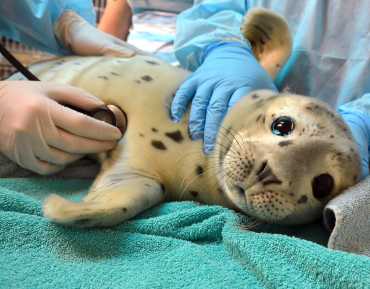
Yes, I want to save a life!
You’ll be giving sick and injured animals the best possible care at the Center’s state-of-the-art hospital. With your gift today, you are giving a patient a second chance at life in the wild.
See Our Latest News
{"image":"\/Animals\/Wild\/California sea lion\/cropped-images\/csl-release-4-5-24photo-by-chris-deimler-c-the-marine-mammal-center-138-0-1270-992-1745348188.jpg","alt":"Four young California sea lions walk on the beach toward the ocean.","title":"Achievements in Ocean Health","link_url":"https:\/\/www.marinemammalcenter.org\/news\/achievements-in-ocean-health","label":"News Update","date":"2025-04-23 10:20:00"}

{"image":"\/Misc\/Graphics\/cropped-images\/climate-change-graphic-giant-earth-shutterstock-1798-6-5113-3994-1680046432.jpg","alt":"An Earth Day graphic of people holding the planet, recycling, planting a tree and moving a solar panel.","title":"5 Ways to Celebrate Earth Day","link_url":"https:\/\/www.marinemammalcenter.org\/news\/5-ways-to-celebrate-earth-day","label":"News Update","date":"2025-04-18 11:21:08"}

{"image":"\/Animals\/Wild\/Sea otter\/cropped-images\/sea-otter-mom-pup-photo-c-brian-simuro-505-0-3387-2646-1618247266.jpg","alt":"sea otter mother and pup","title":"Meaningful Mother\u2019s Day Gifts for Ocean Lovers","link_url":"https:\/\/www.marinemammalcenter.org\/news\/eco-friendly-mothers-day-gifts-that-give-back","label":"News Update","date":"2025-04-10 02:00:00"}

{"image":"\/Animals\/Wild\/Harbor seal\/cropped-images\/harbor-seals-shutterstock-107-0-1270-992-1744225508.jpg","alt":"A group of harbor seal pups and mothers on the beach during pupping season.","title":"Your Guide to Seeing Harbor Seal Pups in California","link_url":"https:\/\/www.marinemammalcenter.org\/news\/your-guide-to-seeing-harbor-seal-pups-in-california","label":"News Update","date":"2025-04-10 00:00:00"}

species conservation
climate change
Guadalupe Fur Seal
